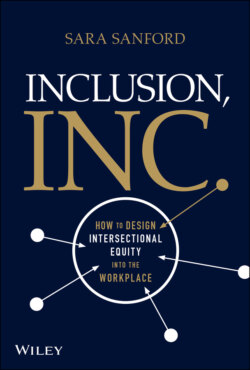Читать книгу Inclusion, Inc. - Sara Sanford - Страница 19
A Quick Guide to the Rest of This Book
ОглавлениеThis book has three goals, pursued in three parts.
The first, tackled in part 1, is to convince you that the trim-tab hypothesis is true. I want you to believe that shifting our perspective on DEI is important, that we need to leave old ways behind and focus on changing mechanics, not mindsets. This part will define who we're changing the workplace for, what will happen to them (and all of us) if we don't change course, and what it looks like to debias processes rather than people.
The second goal, addressed in part 2, is to show you how to implement the trim-tab approach by adjusting cultural levers throughout your organization. You'll learn how to attract more qualified candidates, hire the best person for the role, get the most out of meetings by actually hearing from everyone, and conduct a pay gap audit that's meaningful enough to turn into a pay equity strategy. I'll share why you should scrap the yearly review and what you should do instead. You'll learn why mentorship isn't enough, but sponsorship is, and how to make difficult decisions around transparency and target-setting.
This section will show how policies such as paid leave and flexibility may seem inclusive on the surface, but there is a right and a wrong way to implement them. From recruiting to professional development to office aesthetics and governance strategy, this part will reveal the trim tabs that unlock both social and financial returns.
The third goal is to get a handle on DEI tomorrow. Part 3 reckons with the future but starts by looking at the past, specifically at lessons learned from the COVID-19 pandemic. This probably won't be the last society-wide crisis that employers face, and we can learn from businesses that managed to keep equity in focus, even in the midst of upheaval. Businesses that double down on equity in times of crisis come out of them stronger and continue to outperform the competition. An equitable emergency response plan is a more successful response plan.
Part 3 will also provide tools and principles to navigate how AI and machine learning will impact the workplace. I believe we'll be seeing more and more businesses stating that their DEI strategies are “data-driven.” This doesn't mean that their DEI strategies are data-smart. Depending on how it is collected, analyzed, and interpreted, data can either drive transformative inclusion, or it can become a weapon of math destruction,16 encoding human bias and scaling it across an organization. This section will give you a framework for asking the right questions in your engagement surveys and analyzing DEI data with an intersectional lens.
Finally, this part finishes with DEI principles to live by, including a focus on communication. Alongside the opportunity gaps in many organizations, I also see persistent communication gaps. Managers and executives who want to further their DEI strategies fear that they'll say the wrong thing. Human Resources leaders create effective policies, but employees never hear about them or don't understand the benefits because the message is not communicated clearly. This section covers common DEI communication mistakes and provides alternative scripts that you can rely on for difficult conversations.
≈
Before we move on to learning how to shift our DEI perspectives and embrace more equitable systems, we need to answer one critical question: What if we didn't?
